Kenwood NX-320E3 User Manual
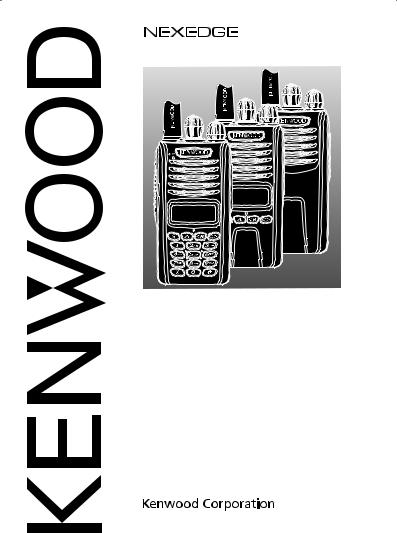
NX-220/ NX-320
VHF DIGITAL TRANSCEIVER/ UHF DIGITAL TRANSCEIVER
INSTRUCTION MANUAL
ÉMETTEUR-RÉCEPTEUR NUMÉRIQUE VHF/ ÉMETTEUR-RÉCEPTEUR NUMÉRIQUE UHF
MODE D’EMPLOI
TRANSCEPTOR DIGITAL VHF/ TRANSCEPTOR DIGITAL UHF
MANUAL DE INSTRUCCIONES
RICETRASMETTITORE DIGITALE VHF/ RICETRASMETTITORE DIGITALE UHF
MANUALE DI ISTRUZIONI
VHF DIGITAL FUNKGERÄT/ UHF DIGITAL FUNKGERÄT
BEDIENUNGSANLEITUNG
VHF DIGITALE ZENDONTVANGER/ UHF DIGITALE ZENDONTVANGER
GEBRUIKSAANWIJZING
VHF SAYISAL EL TELSİZİ/ UHF SAYISAL EL TELSİZİ
KULLANIM KILAVUZU
ΨΗΦΙΑΚΟΣ ΠΟΜΠΟΔΕΚΤΗΣ VHF/ ΨΗΦΙΑΚΟΣ ΠΟΜΠΟΔΕΚΤΗΣ UHF
ΟΔΗΓΙΕΣ ΧΡΗΣΗΣ
© B62-2319-00 (E)
09 08 07 06 05 04 03 02 01 00
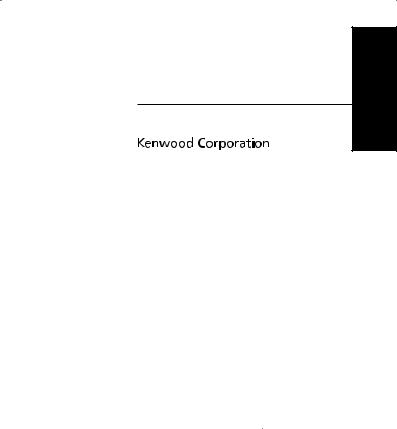
VHF DIGITAL TRANSCEIVER/ UHF DIGITAL TRANSCEIVER
NX-220/ NX-320
INSTRUCTION MANUAL
ENGLISH
NOTIFICATION
This equipment complies with the essential requirements of Directive 1999/5/EC.
The use of the warning symbol means the equipment is subject to restrictions of use in certain countries.
means the equipment is subject to restrictions of use in certain countries.
This equipment requires a licence and is intended for use in the countries as below.
AT |
BE |
DK |
FI |
FR |
DE |
GR |
IS |
|
|
|
|
|
|
|
|
IE |
IT |
LI |
LU |
NL |
NO |
PT |
ES |
|
|
|
|
|
|
|
|
SE |
CH |
GB |
CY |
CZ |
EE |
HU |
LV |
|
|
|
|
|
|
|
|
LT |
MT |
PL |
SK |
SI |
BG |
RO |
|
ISO3166
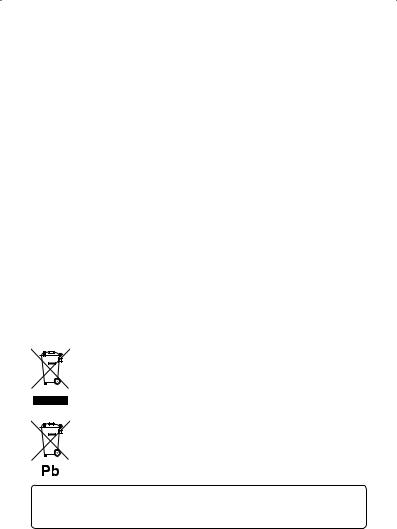
Information on Disposal of Old Electrical and Electronic Equipment and Batteries (applicable for EU countries that have adopted separate waste collection systems)
Products and batteries with the symbol (crossed-out wheeled bin) cannot be disposed as household waste.
Old electrical and electronic equipment and batteries should be recycled at a facility capable of handling these items and their waste byproducts.
Contact your local authority for details in locating a recycle facility nearest to you.
Proper recycling and waste disposal will help conserve resources whilst preventing detrimental effects on our health and the environment.
Notice: The sign "Pb" below the symbol for batteries indicates that this battery contains lead.
Firmware Copyrights
The title to and ownership of copyrights for firmware embedded in Kenwood product memories are reserved for Kenwood Corporation.

THANK YOU
We are grateful you have chosen Kenwood for your land mobile radio applications.
This instruction manual covers only the basic operations of your NEXEDGE portable radio. Ask your dealer for information on any customized features they may have added to your radio.
NXDN™
NXDN™ is a protocol name for a new digital communications system using 4-level FSK technology which has been co-developed by Kenwood and Icom.
NOTICES TO THE USER
Government law prohibits the operation of unlicensed radio transmitters within the territories under government control.
Illegal operation is punishable by fine and/or imprisonment.
Refer service to qualified technicians only.
Safety: It is important that the operator is aware of, and understands, hazards common to the operation of any transceiver.
The AMBE+2™ voice coding Technology embodied in this product is protected by intellectual property rights including patent rights,
copyrights and trade secrets of Digital Voice Systems, Inc. This voice coding Technology is licensed solely for use within this Communications Equipment. The user of this Technology is explicitly prohibited
from attempting to extract, remove, decompile, reverse engineer, or disassemble the Object Code, or in any other way convert the Object Code into a human-readable form. U.S. Patent Nos. #5,870,405, #5,826,222, #5,754,974, #5,701,390, #5,715,365, #5,649,050, #5,630,011, #5,581,656, #5,517,511, #5,491,772, #5,247,579, #5,226,084 and #5,195,166.
i

PRECAUTIONS
•Do not charge the transceiver and battery pack when they are wet.
•Ensure that there are no metallic items located between the transceiver and the battery pack.
•Do not use options not specified by Kenwood.
•If the die-cast chassis or other transceiver part is damaged, do not touch the damaged parts.
•If a headset or headphone is connected to the transceiver, reduce the transceiver volume. Pay attention to the volume level when turning the squelch off.
•Do not place the microphone cable around your neck while near machinery that may catch the cable.
•Do not place the transceiver on unstable surfaces.
•Ensure that the end of the antenna does not touch your eyes.
•When the transceiver is used for transmission for many hours, the radiator and chassis will become hot. Do not touch these locations when replacing the battery pack.
•Do not immerse the transceiver in water.
•Always switch the transceiver power off before installing optional accessories.
•The charger is the device that disconnects the unit from the AC mains line. The AC plug should be readily accessible.

 ii
ii
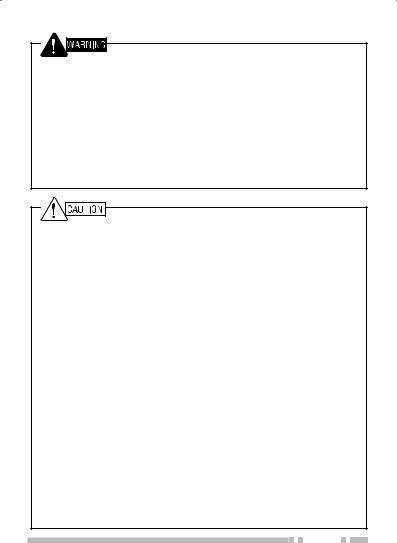
Turn the transceiver power off in the following locations:
•In explosive atmospheres (inflammable gas, dust particles, metallic powders, grain powders, etc.).
•While taking on fuel or while parked at gasoline service stations.
•Near explosives or blasting sites.
•In aircrafts. (Any use of the transceiver must follow the instructions and regulations provided by the airline crew.)
•Where restrictions or warnings are posted regarding the use of radio devices, including but not limited to medical facilities.
•Near persons using pacemakers.
•Do not disassemble or modify the transceiver for any reason.
•Do not place the transceiver on or near airbag equipment while the vehicle is running. When the airbag inflates, the transceiver may be ejected and strike the driver or passengers.
•Do not transmit while touching the antenna terminal or if any metallic parts are exposed from the antenna covering. Transmitting at such a time may result in a high-frequency burn.
•If an abnormal odor or smoke is detected coming from the transceiver, switch the transceiver power off immediately, remove the battery pack from the transceiver, and contact your Kenwood dealer.
•Use of the transceiver while you are driving may be against traffic laws. Please check and observe the vehicle regulations in your area.
•Do not expose the transceiver to extremely hot or cold conditions.
•Do not carry the battery pack with metal objects, as they may short the battery terminals.
•Danger of explosion if the battery is incorrectly replaced; replace only with the same type.
•When operating the transceiver in areas where the air is dry, it is easy to build up an electric charge (static electricity). When using an earphone accessory in such conditions, it is possible for the transceiver to send an electric shock through the earphone and to your ear. We recommend you use only a speaker/microphone in these conditions, to avoid electric shocks.
iii
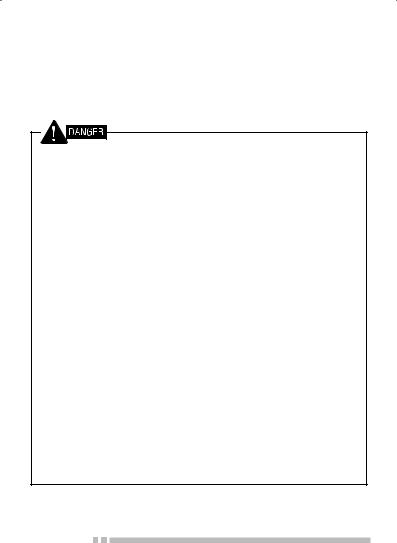
Information concerning the battery pack:
The battery pack includes flammable objects such as organic solvent. Mishandling may cause the battery to rupture producing flames or extreme heat, deteriorate, or cause other forms of damage to the battery. Please observe the following prohibitive matters.
•Do not disassemble or reconstruct battery!
The battery pack has a safety function and protection circuit to avoid danger. If they suffer serious damage, the battery may generate heat or smoke, rupture, or burst into flame.
•Do not short-circuit the battery!
Do not join the + and – terminals using any form of metal (such as a paper clip or wire). Do not carry or store the battery pack in containers holding metal objects (such as wires, chain-necklace or
hairpins). If the battery pack is short-circuited, excessive current will flow and the battery may generate heat or smoke, rupture, or burst into flame. It will also cause metal objects to heat up.
•Do not incinerate or apply heat to the battery!
If the insulator is melted, the gas release vent or safety function is damaged, or the electrolyte is ignited, the battery may generate heat or smoke, rupture, or burst into flame.
•Do not leave the battery near fire, stoves, or other heat generators (areas reaching over 80°C/ 176°F)!
If the polymer separator is melted due to high temperature, an internal short-circuit may occur in the individual cells and the battery may generate heat or smoke, rupture, or burst into flame.
•Avoid immersing the battery in water or getting it wet by other means!
If the battery becomes wet, wipe it off with a dry towel before use. If the battery’s protection circuit is damaged, the battery may charge at extreme current (or voltage) and an abnormal chemical reaction may occur. The battery may generate heat or smoke, rupture, or burst into flame.

 iv
iv
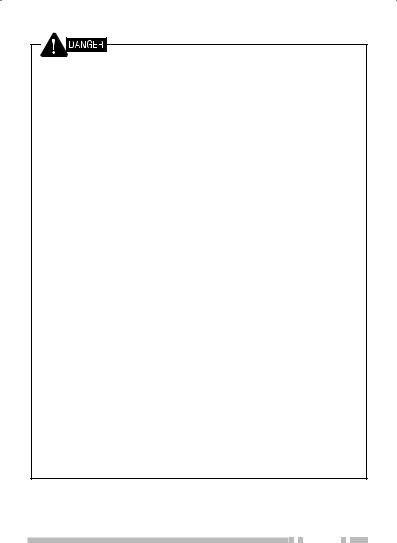
•Do not charge the battery near fire or under direct sunlight!
If the battery’s protection circuit is damaged, the battery may charge at extreme current (or voltage) and an abnormal chemical reaction may occur. The battery may generate heat or smoke, rupture, or burst into flame.
•Use only the specified charger and observe charging requirements!
If the battery is charged in unspecified conditions (under high temperature over the regulated value, excessive high voltage or current over regulated value, or with a remodeled charger), it may overcharge or an abnormal chemical reaction may occur. The battery may generate heat or smoke, rupture, or burst into flame.
•Do not pierce the battery with any object, strike it with an instrument, or step on it!
This may break or deform the battery, causing a short-circuit. The battery may generate heat or smoke, rupture, or burst into flame.
•Do not jar or throw the battery!
An impact may cause the battery to leak, generate heat or smoke, rupture, and/or burst into flame. If the battery’s protection circuit is damaged, the battery may charge at an abnormal current (or voltage), and an abnormal chemical reaction may occur. The battery may generate heat or smoke, rupture, or burst into flame.
•Do not use the battery pack if it is damaged in any way!
The battery may generate heat or smoke, rupture, or burst into flame.
•Do not solder directly onto the battery!
If the insulator is melted or the gas release vent or safety function is damaged, the battery may generate heat or smoke, rupture, or burst into flame.
•Do not reverse the battery polarity (and terminals)!
When charging a reversed battery, an abnormal chemical reaction may occur. In some cases, an unexpected large amount of current may flow upon discharging. The battery may generate heat or smoke, rupture, or burst into flame.
v
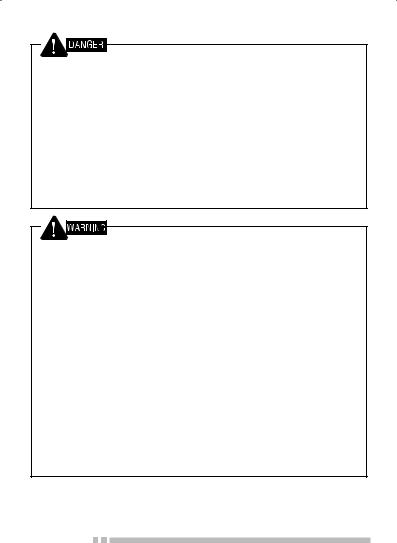
•Do not reverse-charge or reverse-connect the battery!
The battery pack has positive and negative poles. If the battery pack does not smoothly connect with a charger or operating equipment, do not force it; check the polarity of the battery. If the battery pack is reverse-connected to the charger, it will be reversecharged and an abnormal chemical reaction may occur. The battery may generate heat or smoke, rupture, or burst into flame.
•Do not touch a ruptured and leaking battery!
If the electrolyte liquid from the battery gets into your eyes, wash your eyes with fresh water as soon as possible, without rubbing your eyes. Go to the hospital immediately. If left untreated, it may cause eye-problems.
•Do not charge the battery for longer than the specified time!
If the battery pack has not finished charging even after the regulated time has passed, stop it. The battery may generate heat or smoke, rupture, or burst into flame.
•Do not place the battery pack into a microwave or high pressure container!
The battery may generate heat or smoke, rupture, or burst into flame.
•Keep ruptured and leaking battery packs away from fire!
If the battery pack is leaking (or the battery emits a bad odor), immediately remove it from flammable areas. Electrolyte leaking from battery can easily catch on fire and may cause the battery to generate smoke or burst into flame.
•Do not use an abnormal battery!
If the battery pack emits a bad odor, appears to have different coloring, is deformed, or seems abnormal for any other reason, remove it from the charger or operating equipment and do not use it. The battery may generate heat or smoke, rupture, or burst into flame.

 vi
vi
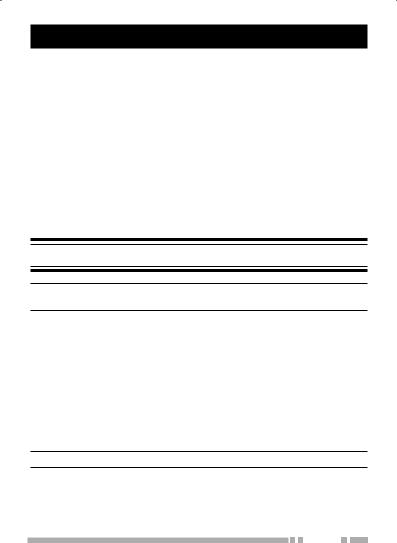
CONTENTS |
|
UNPACKING AND CHECKING EQUIPMENT .................................... |
1 |
PREPARATION ................................................................................... |
2 |
ORIENTATION..................................................................................... |
6 |
PROGRAMMABLE AUXILIARY FUNCTIONS.................................. |
10 |
BASIC OPERATIONS........................................................................ |
12 |
SCAN ................................................................................................. |
15 |
FleetSync: ALPHANUMERIC 2-WAY PAGING FUNCTION............ |
17 |
5-TONE SIGNALING ......................................................................... |
20 |
ADVANCED OPERATIONS .............................................................. |
23 |
BACKGROUND OPERATIONS ........................................................ |
28 |
UNPACKING AND CHECKING EQUIPMENT
Note: These unpacking instructions are for use by your Kenwood dealer, an authorized Kenwood service facility, or the factory.
Carefully unpack the transceiver. If any items are missing or damaged, file a claim with the carrier immediately.
SUPPLIED ACCESSORIES |
|
Belt clip................................................................................................. |
1 |
Speaker/ microphone jacks cap ........................................................... |
1 |
Speaker/ microphone locking bracket .................................................. |
1 |
Stopper (types I and II only) ................................................................. |
1 |
Instruction manual ................................................................................ |
1 |
Note: Inquire at your dealer for a stopper. |
|
1
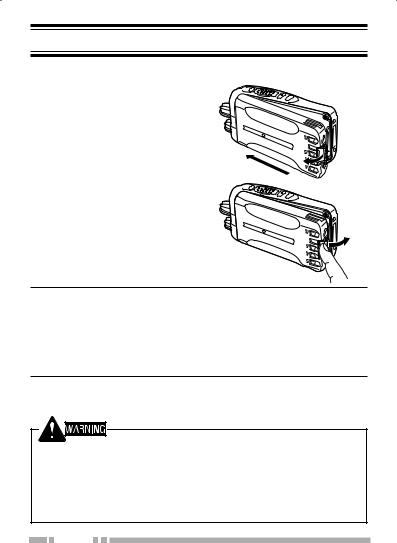
PREPARATION
INSTALLING/ REMOVING THE (OPTIONAL) BATTERY PACK
1 Match the guides of the battery pack with the grooves on the upper rear of the transceiver, then firmly press the battery pack in place.
2 Lock the safety catch to |
2 |
prevent accidentally releasing |
1 |
|
|
the battery pack. |
|
3To remove the battery pack, lift the safety catch, press the
release latch, then pull the
battery pack away from the 3 transceiver.
Note:
For battery pack charging procedures and useage, refer to the battery charger Instruction Manual.
The battery pack is not charged at the factory; charge it before use.
Before charging a battery pack that is attached to the transceiver, ensure that the safety catch is firmly closed.
INSTALLING/ REMOVING ALKALINE BATTERIES (OPTIONAL BATTERY CASE)
Do not install batteries in a hazardous environment where sparks could cause an explosion.
Never discard batteries in fire; extremely high temperatures can cause batteries to explode.
Do not short circuit the battery case terminals.
Do not use rechargeable batteries.
2
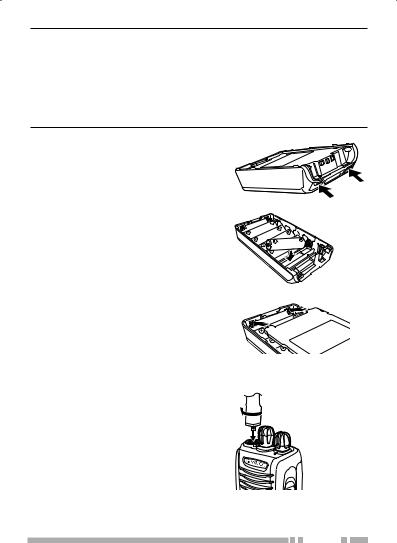
Note:
If you do not plan to use the transceiver for a long period, remove the batteries from the battery case.
This battery case has been designed for transmitting at a power of approximately 1 W (the low power setting on your transceiver). If you want to transmit a stronger signal (using the high power setting on your transceiver), use an optional rechargeable battery pack.
1 To open the battery case, press on the two tabs on the upper rear of the case, then pull the two halls apart.
2 Insert 6 AA (LR6) Alkaline batteries into the battery case.
• Be sure to match the polarities with those marked in the bottom of the battery case.
3 Align the tabs of the cover with the base, then push down on the cover until it locks in place.
INSTALLING THE (OPTIONAL) ANTENNA
Screw the antenna into the connector on the top of the transceiver by holding the antenna at its base and turning
it clockwise until secure.
3
